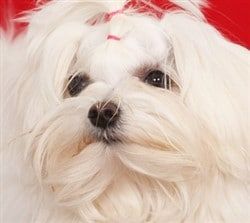Maltese Skin Problems
Overview
The skin of the Maltese breed is a bit more prone to certain issues than other breeds for several reasons. The white, single layer coat of hair does not provide much protection from the sun and other environmental factors. There is also less cushioning than there is with his double-coat furred counterparts.
This section will cover some commonly seen skin disorders and conditions with the Maltese, as well as go over skin issues that can be resolved at home, including dry skin and itching.
Please note:
PetMaltese is reader-supported. Some of the product suggestions on this page are affiliate links. As an Amazon Associate we earn from qualifying purchases. This is at no extra cost to you and helps us continue creating useful content.
Already know that your Maltese has a dry skin problem without other issues?
Jump right to Maltese Dry Skin and Itching.
Skin Discoloration
Most Maltese have pink skin, which is usually very noticeable on the belly.
As a Maltese matures, you may notice a change in color.
This may be a darkening all over or it may show as grey or black spotting.
This may increase in the summer and decrease in the winter or changes may be permanent.
Without any other signs or symptoms, most issues with skin turning black on a Maltese
are due to sun exposure.
In these cases, applying sunscreen can help fade these types of spots. Any dark spots in which the skin is raised should be brought to the attention of the veterinarian.
Sebaceous Adenitis (SA)
Overview:
This is a rare, hereditary skin disorder in which antibodies attack the skin glands. It affects at least 60 different dog breeds, including the Maltese. In moderate to severe cases, the glands are permanently destroyed. Unfortunately, the cause of SA is unknown; however there are treatments that can help.
Age of onset: This can develop at any age, however approximately 60% of cases are with dogs under the age of 2 years old. Older adults are susceptible as well; however, it is rarely seen with senior Maltese
that have had no prior serious skin issues.
Symptoms:
- Flaking and/or scaling of the skin
- Darkening pigmentation
- Odor – often described as a musty smell
- Skin thickens (usually once this disease progresses)
- Thinning of the hair that often worsens to complete hair loss
along several areas of the body
- Itching (sometimes intense)
- Sores can develop
- Secondary infection can set in, as skin become inflamed
Diagnosis:
This is diagnosed with a skin biopsy.
Treatment:
There is no cure for this; however there are several treatments that can ease discomfort and work to restore the skin.
- Gentle removal of scales – This is done with careful combing and baths (see next bullet point).
- Bath rinses may include medicated oils that work to remove scales and moisture the skin. Antimicrobial baths may also be advised.
- Omega 3 and Omega 6 supplements may be given, as these improve both skin and coat health.
Skin Yeast Infections
Overview: A certain amount of yeast (malassezia pachydermatis) is always present on the skin of dogs. When there is an overgrowth of this, it is referred to as a skin yeast infection. The Maltese breed is one of several that are genetically predisposed to developing yeast infections.
This can affect the entire body; however, most commonly it is seen around the genitals, mouth, ears, and/or neck since yeast thrives in moist warm areas.
Symptoms:
- Itchy skin – A Maltese may shake his head, rub areas of his body against surfaces in an effort to relieve the itch and/or chew or lick at infected areas.
- Odor – A telltale sign is an unusual odor, often defined as a greasy smell.
- Crusty scales on the skin
- Visible changes to the skin – Affected areas may be red, swollen, irritated, and/or appear oily.
- Hair loss – Left untreated, hair may thin out
- Color changes – With some Maltese, the skin may turn black
Diagnosis:
This is diagnosed by testing a skin sample. This may be obtained via a smear, scraping, cotton swab swipe, or skin biopsy.
Treatment:
- Shampoos – Special medicated shampoos are often prescribed, which contain chlorhexidine (kills bacteria) and ketoconazole (anti-fungal) such as Curaseb's Antifungal & Antibacterial Chlorhexidine Shampoo w/Ketoconazole
. Those with sulfur and benzoyl peroxide and work as well.
- Sprays – If a Maltese has only a small infected area of skin, a medicated spray can be used.
- Creams – Topical creams may be prescribed that are applied directly to the surface of the affected skin.
- Ear cleaning
– If the ears carry a yeast infection, the veterinarian may rinse them at the office, followed by instructions to do so at home with a medicated solution.
Ringworm
Overview: The most common fungal skin condition with the Maltese breed is ringworm (Microsporum canis). This is highly transmittable and can be passed back and forth from dogs to humans. It is initially picked up via spores found in soil; however a Maltese can catch this from other dogs when playing at the dog park, while in doggie day care, etc.
Symptoms:
- Most of the time, affected areas will be circular in shape. There will be dark pink to red areas, often with scaly skin in the center and a thinning (or loss) of hair around this. This may appear on any part of the body including the head, paws, and tail.
- Other areas may not show the typical round markings, but will be irregular shaped formations of red irritated skin usually with a crusted area.
- If it has spread to the nail area, nails may become brittle, with cracking and deformation.
- A secondary infection may set in, bacterial in nature, that causes itching.
- This can be found anywhere on the body, including the head, paws and tail.
Diagnosis:
Circular shaped hair loss and skin lesions can also be a symptom of mange or black fly bites and for this reason a clear identification is important. The veterinarian will perform a fungal culture of skin and/or hairs.
Treatment:
- A topical anti-fungal cream will be prescribed. This is generally applied to a Maltese’s affected skin 2 times per day for 5 to 6 weeks.
- An anti-fungal shampoo (usually one containing miconazole) may be added to this treatment regimen.
- An oral anti-fungal medication (typically Griseofulvin) may be prescribed.
In severe cases, if a Maltese has long hair, the coat may need to be shaved in order for the medication to effectively reach the skin.
The house must also be treated, since ringworm spores can live on surfaces for up to one year.
- If a Maltese has a dog bed, this should be removed and replaced.
- Grooming tools and hard surface flooring should be sterilized using a 10:1 ratio of water to bleach.
- Carpeting should sprayed with an anti-fungal spray and preferably steam-cleaned.
- Until the Maltese has recovered, any humans who touch the puppy or dog should frequently wash their hands.
- Owner’s clothing and bedding should be washed with hot water, and when possible, with bleach.
While washing should kill spores, home remedies also include spraying clothes with a mixture of white vinegar and water (testing fabric first) before washing or adding Borax to the load.
Mites and Mange
Overview: Skin mites are normally found in small numbers on all dogs, the Maltese included. If these mites multiply, it can cause a case of mange. This affects both skin and coat.
Symptoms:
- Scabbing on the skin – if not treated this will spread, eventually covering most of the body
- Intense itching that causes a dog to bite, lick, or scratch themselves
- Red, inflamed sores
- Hair loss on infected areas
Diagnosis:
Many veterinarians can identify this simply by looking at a dog; however, a scraping of the skin to observe under a microscope may be done to confirm the diagnosis.
Treatment:
Topical medication, oral medication or both will be prescribed. It is important to follow application and dosing directions carefully. If a Maltese is found to have sarcoptic mange, which is highly contagious, he or she may need to be isolated while being treated. Anti-inflammatory medication may also be given.
Maltese Dry Skin and Itching
As we touched on above, the Maltese breed is prone to general skin issues including dry and/or itchy skin. In some cases, this will be due to underlying issues that will need to be resolved, such as allergies. However, in some cases, skin problems will develop due to environmental factors.
Top causes of skin issues include:
Allergies
- No matter what type of allergy a Maltese may be suffering from, skin eruptions are very common. Taking steps to resolve allergies with your Maltese
is important, and we will cover immediate relief ahead.
Inferior food - Ingredients found in poorly-made dog foods can affect a puppy or dog's skin and coat. Culprits include fillers, heavy grain content, and chemical additives (coloring, flavoring, and/or preservatives). Common signs are itchy skin, rash, hot spots, and/or changes in coat texture.
If you suspect that your Maltese's food may be to blame for ongoing, chronic skin issues, it will be time to reassess what you are feeding your puppy or dog.
You may want to consider Wellness CORE Natural Dry Grain-Free for Small Breed Dogs , which is a top rated food with zero additives, no soy, no grain, no by-products, and is made in the USA.
, which is a top rated food with zero additives, no soy, no grain, no by-products, and is made in the USA.
Be careful about which snacks you give to your Maltese
too. These should be held to the same standards as the main kibble.
Frequency of baths
- Baths should be given once every 3 weeks. More than this can cause drying issues, and less than this can cause oily skin issues.
Another issue is shampoos that do not properly remove oils and/or leaves residue that blocks skin pores. Be sure to only use quality shampoos and coat products
on your Maltese.
Weather-related elements
- Wintertime weather can take a toll on Maltese dogs. Typically, the air is much dryer (holds much less humidity), so over the course of weeks and months, skin can dry out.
How to Fix Common Skin Issues
1. Address the root causes.
To successfully treat itchy dry skin problems, it is important that you first rule out the top causes as listed above, and that any suspected health conditions are ruled out. If not, you may only see temporary results.
2. In the winter, work to increase the humidity in the house.
This is best done with humidifiers. Other things that can help to a smaller degree include having lots of houseplants, leaving the bathroom door open when showering, and leaving out containers of water (particularly when placed over heating elements).
3. Encourage your Maltese to drink enough water.
Even slight de-hydration can cause the skin to dry out. Fresh cool water in a stainless-steel or ceramic bowl should be left out at all times and swapped out often (not just topped off). For dogs that need extra motivation, the running water of a canine fountain can help.
4. Use products to treat the issue.
If a Maltese has hot spots (red, irritated skin), peeling, and/or intense itching caused by excessive dry skin, it is often best to begin by using specialized products. Let's look at the options:
1) A topical, non-medicated spray.
A topical spray can offer immediate relief and this is a good choice if the issue is on an area that your Maltese can reach to lick or gnaw at, like the paws. All-natural remedies like this can be used multiple times, round the clock.
For this, Bodhi Dog's Oatmeal and Baking Soda Spray
 is very effective. The blend of oatmeal and baking soda is a great anti-itch combination and there is a vitamin blend to help heal the skin. This can be applied every 2 to 3 hours, or just as needed.
is very effective. The blend of oatmeal and baking soda is a great anti-itch combination and there is a vitamin blend to help heal the skin. This can be applied every 2 to 3 hours, or just as needed.
2) A topical medicated spray.
Some cases warrant a medicated spray such as cases of severe itching or extremely irritated skin and this option works best on areas that a dog cannot reach (to lick or bite) or if you can prevent licking or chewing via socks on the paws or by using a recovery collar.
For this, SynergyLabs Clinical Care Medicated Spray
 is a terrific choice. This has hydrocortisone which is an anti-itch and anti-inflammatory and lidocaine which is a numbing agent. This also has colloidal oatmeal to soothe and bring moisture back to the skin.
is a terrific choice. This has hydrocortisone which is an anti-itch and anti-inflammatory and lidocaine which is a numbing agent. This also has colloidal oatmeal to soothe and bring moisture back to the skin.
3) A specialized shampoo.
While sprays are good for targeting certain body areas and are great to offer relief as needed, soaking your Maltese in the tub, lathered in a specialized shampoo, is a way to offer full-body healing and relief.
For this, Moosh Natural Dog Shampoo
 is quite remarkable. This works for just about any skin issue that a dog has, and is particularly helpful even if you cannot quite pinpoint the cause of the skin problem. This works on insect bites, allergy reactions, mites, mange, yeast, and more. And, it does this all with a special blend of all-natural, organic ingredients.
is quite remarkable. This works for just about any skin issue that a dog has, and is particularly helpful even if you cannot quite pinpoint the cause of the skin problem. This works on insect bites, allergy reactions, mites, mange, yeast, and more. And, it does this all with a special blend of all-natural, organic ingredients.
This has bentonite clay that draws impurities out of the skin, shea butter and aloe (two very soothing ingredients), argan oil, neem oil, nutmeg and rosemary. There are zero artificial additives and no chemical preservatives or sulfates.

-min-450x169-1920w.jpg)


